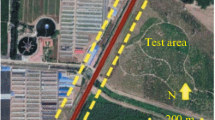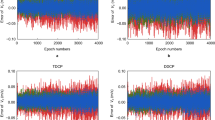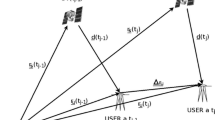Abstract
In this work, a new GPS carrier phase-based velocity and acceleration determination method is presented that extends the effective range of previous techniques. The method is named ‘EVA’, and may find applications in fields such as airborne gravimetry when rough terrain or water bodies make difficult or impractical to set up nearby GPS reference receivers. The EVA method is similar to methods such as Kennedy (Precise acceleration determination from carrier phase measurements. In: Proceedings of the 15th international technical meeting of the satellite division of the Institute of Navigation. ION GPS 2002, Portland pp 962–972, 2002b) since it uses L1 carrier phase observables for velocity and acceleration determination. However, it introduces a wide network of stations and it is independent of precise clock information because it estimates satellite clock drifts and drift rates ‘on-the-fly’, requiring only orbit data of sufficient quality. Moreover, with EVA the solution rate is only limited by data rate, and not by the available precise satellite clocks data rate. The results obtained are more robust for long baselines than the results obtained with the reference Kennedy method. An advantage of being independent of precise clock information is that, beside IGS Final products, also the Rapid, Ultra-Rapid (observed) and Ultra-Rapid (predicted) products may be used. Moreover, the EVA technique may also use the undifferenced ionosphere-free carrier phase combination (LC), overcoming baseline limitations in cases where ionosphere gradients may be an issue and very low biases are required. During the development of this work, some problems were found in the velocity estimation process of the Kennedy method. The sources of the problems were identified, and an improved version of the Kennedy method was used for this research work. An experiment was performed using a light aircraft flying over the Pyrenees, showing that both EVA and the improved Kennedy methods are able to cope with the dynamics of mountainous flight. A RTK-derived solution was also generated, and when comparing the three methods to a known zero-velocity reference the results yielded similar performance. The EVA and the improved-Kennedy methods outperformed the RTK solutions, and the EVA method provided the best results in this experiment. Finally, both the improved version of the Kennedy method and the EVA method were applied to a network in equatorial South America with baselines of more than 1,770 km, and during local noon. Under this tough scenario, the EVA method showed a clear advantage for all components of velocity and acceleration, yielding better and more robust results.
Similar content being viewed by others
References
ARL (2010) The GPS Toolkit, GPSTk [Online; accessed November 20th, 2010]. http://www.gpstk.org/
Bruton AM (2000) Improving the accuracy and resolution of SINS/DGPS airborne gravimetry. PhD thesis. Department of Geomatics Engineering, University of Calgary, Calgary, Alberta, Canada. Report No. 20145
Bruton AM, Glennie CL, Schwarz KP (1999) Differentiation for high-precision GPS velocity and acceleration determination. GPS Solut 2(4): 7–21
Cannon ME, Lachapelle G, Szarmes MC, Hebert JM, Keith J, Jokerst S (1997) DGPS kinematic carrier phase signal simulation analysis for precise velocity and position determination. J Inst Navig 44(2): 231–246
Dahlquist G, Bjork A (1974) Numerical methods. Prentice Hall, Englewood Cliffs. ISBN 0-13-627315-7
Hofmann-Wellenhof B, Lichtenegger KH, Wasle E (2008) GNSS—Global navigation satellite systems. Springer, Wien
Jekeli C (1994) On the computation of vehicle accelerations using GPS phase accelerations. In: Proceedings of the international symposium on kinematic systems in geodesy, geomatics and navigation (KIS94), Banff, Canada, pp 473–481
Jekeli C, Garcia R (1997) GPS phase accelerations for moving-base vector gravimetry. J Geodesy 71(10): 630–639. doi:10.1007/s001900050130
Kennedy S (2002a) Acceleration estimation from GPS carrier phases for airborne gravimetry Master’s thesis. Department of Geomatics Engineering, University of Calgary, Calgary, Alberta, Canada report no. 20160
Kennedy S (2002b) Precise acceleration determination from carrier phase measurements. In: Proceedings of the 15th international technical meeting of the satellite division of the Institute of Navigation. ION GPS 2002, Portland, pp 962–972
Kouba J (2009) A guide to using International GNSS Service (IGS) products. Tech. rep., International GNSS Service, http://acc.igs.org/UsingIGSProductsVer21.pdf
Misra P, Enge P (2006) Global positioning system. Signals, measurements and performance. Ganga-Jamuna Press, USA
Parkinson BW, Spilker Jr JJ (1996) Global positioning system: theory and applications, vol I & II. American Institute for Aeronautics and Astronautics, USA
Radovanovic RS, El-Sheimy N, Teskey W (2001) Rigorous combination of GPS data from multiple base stations for mobile platform positioning. In: Proceedings of the 3rd international symposium on mobile mapping technology, Cairo, Egypt
Salazar D, Hernandez-Pajares M, Juan J, Sanz J (2010) GNSS data management and processing with the GPSTk. GPS Solut 14(3): 293–299. doi:10.1007/s10291-009-0149-9
Szarmes M, Ryan S, Lachapelle G, Fenton P (1997) DGPS high accuracy aircraft velocity determination using Doppler measurements. In: Proceedings of the international symposium on kinematic systems (KIS97), Banff, Alberta, Canada
Takasu T, Yasuda A (2009) Development of the low-cost RTK-GPS receiver with an open source program package rtklib. In: Proceedings of international symposium on GPS/GNSS, Jeju, Korea
van Graas F, Soloviev A (2004) Precise velocity estimation using a stand-alone GPS receiver. NAVIGATION. J Inst Navig 51(4): 283–292
Walter T, Enge P, Hansen A (1997) A proposed integrity equation for WAAS MOPS. In: Proceedings of the 10th international technical meeting of the Satellite Division of The Institute of Navigation (ION GPS 1997), Kansas City, USA, pp 475–484
Zhang X, Forsberg R (2007) Assessment of long-range kinematic GPS positioning errors by comparison with airborne laser altimetry and satellite altimetry. J Geodesy 81(3): 210–211. doi:10.1007/s00190-006-0100-6
Author information
Authors and Affiliations
Corresponding author
Rights and permissions
About this article
Cite this article
Salazar, D., Hernandez-Pajares, M., Juan-Zornoza, J.M. et al. EVA: GPS-based extended velocity and acceleration determination. J Geod 85, 329–340 (2011). https://doi.org/10.1007/s00190-010-0439-6
Received:
Accepted:
Published:
Issue Date:
DOI: https://doi.org/10.1007/s00190-010-0439-6




